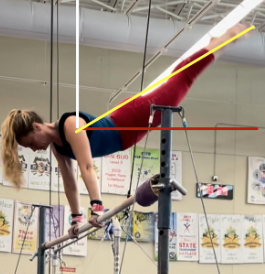Bars is one of my favorite events to judge and my favorite to compete as an athlete. A well-executed bar routine has this beautifully graceful swing and momentum, where the athlete seems to effortlessly float around the bars as they move through and into each skill. In this article, I will break down some of the most common, surprising and rarely taken deductions in NCAA routines.
Handstand Deductions
On bars, judges are looking for handstands, handstands and more handstands. Anytime you cast, swing, circle or turn on bars, it’s expected to be done in—or very close to—a handstand. If not, skills are devalued and/or deducted, with more severe penalties for skills that are farther from the handstand.
The amplitude, or height, of a skill expected to finish in handstand is determined by drawing an imaginary line from the athlete’s shoulder to the lowest point of their body. In the photo below, the red line indicates the actual angle of the athlete’s cast and the yellow indicates the perceived angle of the cast based on the height of her feet. This cast would incur a three-tenth deduction for amplitude, plus an up-to-two-tenth body-position deduction (I’d take one tenth for this amount of arch). College athletes have anywhere from four to seven skills that finish or pass through handstand, and judges are looking at their angles and body position closely each time.

In skills where athletes turn in a handstand, the skill is considered complete once the athlete has completed the turn and re-grasped the bar. And, it must be done within 20 degrees of vertical to receive no deduction. In the video below, the athlete completes the turn right at 20 degrees from a handstand, although in real time the turn seems to be a bit later or lower, especially with her re-grip into her giant swing. This is where experience and the viewpoint of the judge may cause some differences of opinion regarding whether this turn would incur a deduction, with less experienced judges more likely to take a half to one-tenth deduction for the turn.
https://www.giphy.com/gifs/g0KtBxR4P8SboWKeCc
https://www.giphy.com/gifs/g0KtBxR4P8SboWKeCc
Releases
The other major point of evaluation is the release skills on bars, both single-bar releases and those involving a bar change (high to low bar or low to high bar). These skills are impressive no matter how well executed they are, and to the untrained eye it’s difficult to differentiate between those that are completed safely and those that are performed exceptionally.
Judges are of course looking for form and body position in the air, but they are also looking at the degree of rotation in the air, as well as the amplitude (height) of the skill. Single-bar release skills should finish with the athlete’s hips above the level of the high bar and their arms straight and fully extended, with the rotation completed prior to regrasping the bar. For releases that transition between the bars, the hips should reach the level of the high bar and should finish with controlled momentum into the next swing, in whatever position is expected for the skill. Judges can deduct up to one tenth for underrotation, up to two tenths for insufficient amplitude, up to three tenths for arm bend and up to two tenths for body position.
The other major point of evaluation is the landing of the dismount, including the body position in the air (up to two tenths) and into the landing (up to three tenths), arm movements (up to one tenth), degree of squat (up to three tenths), distance (up to one tenth) and number of steps (up to four tenths). Some other large errors that athletes can make that don’t aesthetically seem to be too serious are compositional deductions and extra swings. If an athlete has to stop between skills during the routine or adds an extra swing on the high bar, it’s a flat three-tenth deduction each time.
Additionally, gymnasts are required to perform specific elements and high-level combinations in order to start at a 10.0 maximum score and not incur additional compositional deductions. Coaches and athletes have to balance safety, consistency and quality of their performances with difficulty. It’s often smarter to do an easier routine that is clean and consistent that may have a lower maximum score or incur a composition deduction, than to perform skills that are not well-mastered or inconsistent.
Rarely Taken Deductions
Deductions that are not (or rarely) taken in college fall into one of three categories: 1) It’s hard or impossible to see from the judge’s viewpoint, 2) they are not deductions commonly incurred in high-level NCAA athletes or 3) they shouldn’t even be a deduction so we just pretend it’s not in the code.
Leg separation on Pak saltos or double layouts are very difficult to see from the side, so you might see a 10.0 bar routine even with clear leg separation on the Pak salto. Deductions like “exactness of handstands throughout” or “dynamics” on bars are rarely, if ever, taken in college since they would only apply to athletes that are already very low-scoring (which feels like kicking someone when they’re down). My absolute least favorite deduction in the code of points is “insufficient extension in a glide kip,” which I have never taken (even though I probably should have), and I know most other judges do not take it either, as they would have robbed Kyla Ross and many other NCAA star bars athletes of their perfect 10s—and no one wants that.
READ THIS NEXT: Judge’s Inquiry: Height, Distance and Other Things You Thought You Knew About Vault Judging
Article by Rhiannon Franck
Rhiannon Franck is a former national-rated NAWGJ women’s gymnastics judge with over 15 years of USAG judging experience and nine seasons judging NCAA gymnastics. Outside of gymnastics, Franck works at a university as a nursing professor and loves to travel. You can follow her on Instagram and Twitter.
Like what you see? Consider donating to support our efforts throughout the year!


